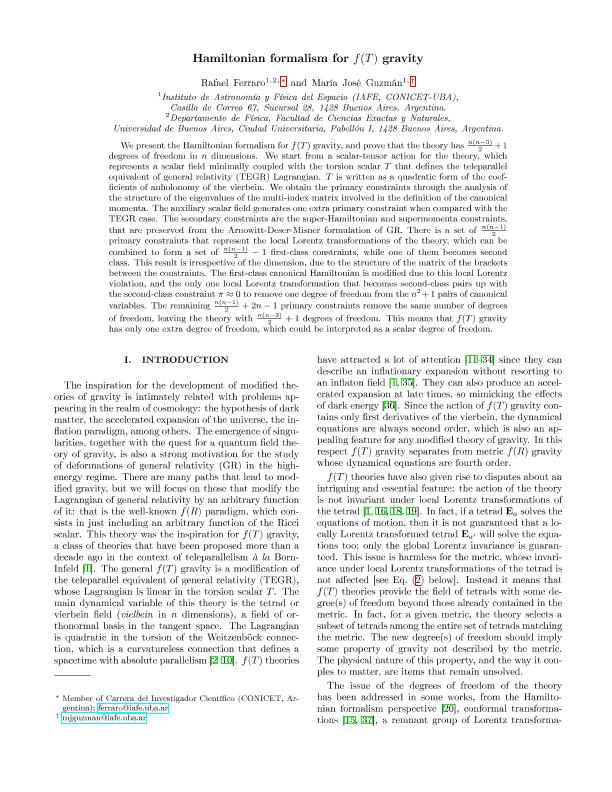Artículo
Hamiltonian formalism for f (T) gravity
Fecha de publicación:
05/2018
Editorial:
American Physical Society
Revista:
Physical Review D
ISSN:
2470-0010
Idioma:
Inglés
Tipo de recurso:
Artículo publicado
Clasificación temática:
Resumen
We present the Hamiltonian formalism for f(T) gravity, and prove that the theory has n(n−3)/2+1 degrees of freedom (d.o.f.) in n dimensions. We start from a scalar-tensor action for the theory, which represents a scalarfield minimally coupled with the torsion scalar T that defines the teleparallel equivalent of general relativity (TEGR) Lagrangian. T is written as a quadratic form of the coefficients of anholonomy of the vierbein. We obtain the primary constraints through the analysis of the structure of the eigenvalues of the multi-index matrix involved in the definition of the canonical momenta. The auxiliary scalar field generates one extra primary constraint when compared with the TEGR case. The secondary constraints are the superHamiltonian and supermomenta constraints, that are preserved from the Arnowitt-Deser-Misner formulation of GR. There is a set of n(n−1)/2 primary constraints that represent the local Lorentz transformations of the theory, which can be combined to form a set of n(n−1)/2−1 first-class constraints, while one of them becomessecond class. This result is irrespective of the dimension, due to the structure of the matrix of the brackets between the constraints. The first-class canonical Hamiltonian is modified due to this local Lorentz violation, and the only one local Lorentz transformation that becomes second-class pairs up with the second-class constraint π ≈ 0 to remove one d.o.f. from the n^2+1 pairs of canonical variables. The remaining n(n−1)/2+2n−1 primary constraints remove the same number of d.o.f., leaving the theory with n(n−3)/2+1 d.o.f. This means that f(T) gravity has only one extra d.o.f., which could be interpreted as a scalar d.o.f.
Palabras clave:
Modified Gravity
,
Teleparallelism
,
Degrees of Freedom
Archivos asociados
Licencia
Identificadores
Colecciones
Articulos(IAFE)
Articulos de INST.DE ASTRONOMIA Y FISICA DEL ESPACIO(I)
Articulos de INST.DE ASTRONOMIA Y FISICA DEL ESPACIO(I)
Citación
Ferraro, Rafael; Guzmán Monsalve, María José; Hamiltonian formalism for f (T) gravity; American Physical Society; Physical Review D; 97; 10; 5-2018; 1-16
Compartir




